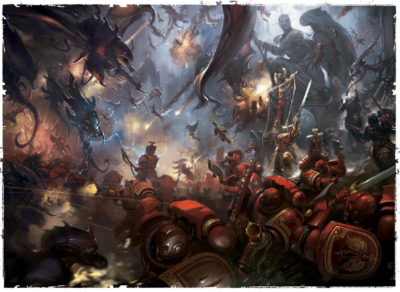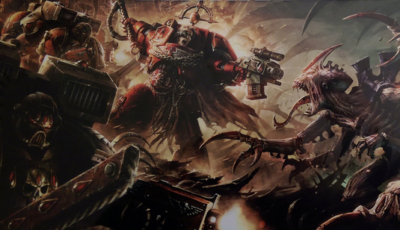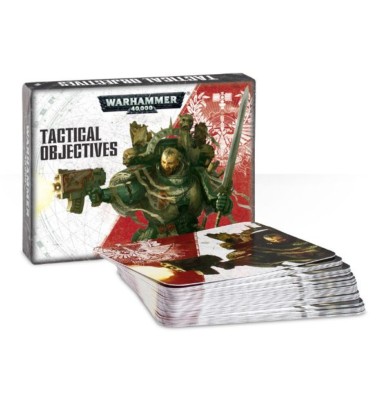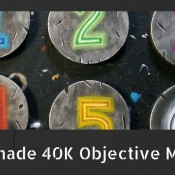Greetings Wargamers and Hobbyists and welcome to another round of rambling for your reading pleasure.
For this article I wanted to talk briefly about a recent game of Warhammer 40,000 I played for which I played using the Maelstrom Missions and cards for the first time. Though the missions and cards have been around since 7th Edition exploded onto the gaming scene, this was my first opportunity to try them out, as not only had I been out of gaming from autumn last year until only about three months ago, when I did get back into gaming it was just as Age of Sigmar dropped, and so that stole the limelight for several weeks.
Maelstrom of War
Of course I imagine many of you have tried the missions and cards for yourselves by now, so I won’t go into exhaustive detail about how the cards work, but I will talk about what I thought about playing with them, and where I think they work well, and not so well.
For the game in question we agreed on 2,000 points, and I decided to unleash my Tyranids against a club mate’s Blood Angels. I had played Blood Angels not a million years ago using my Dark Eldar, so knew reasonably well the importance of being able to deal with characters like Mephiston and The Sanguinor, but also expected to see multiple Drop Pods and Dreadnoughts enter the fray, and perhaps a Land Raider. By the time we had rolled up the battle we ended up with a Vanguard Strike deployment and rather aptly, the ‘Purge the Alien’ mission.
Though I understood how the objectives in Maelstrom Missions worked, I wasn’t hugely familiar with the deck of cards, so I thought it best to deploy my Swarm to maximise on the various benefits from Synapse and Venomthrope cover saves, and pointed the army towards the greatest concentration of objective markers.
I like to play an ‘all-rounder’ kind of army, so I had plenty of small critters in large units or 15+ models, to give me plenty of bodies to soak up damage and shield the larger beasts which I hoped would cause damage. I took a Hive Tyrant on foot, because he was easy to hide behind other models, which in turn were shielded by progressively smaller critters until we got to the Gaunts at the front of the Swarm, by which time the big stuff at the back was claiming a healthy 3+ cover save, and there were too few Blood Angels to really chew through the 70+ small Tyranids that were charging towards them before the pair of Carnifex and the Hive Tyrant got into combat.
I was also trying out my Hive Crone for the first time, which I had taken with hunting Land Raiders in mind with their multiple haywire inflicting Tentaclids, but which in the end only had a Vindicator to contend with, and four Dreadnoughts. Joining battle for the first time as well were the pair of Venomthropes, and a Broodlord, which I had acquired to lead my large-ish unit of Genestealers.
Battle Report
In this game one thing that became clear from the outset was that having access to drop pods gives the Astartes a huge early game advantage, as being able to land pretty much anywhere you want them to with far less risk than other Deepstriking units, the Blood Angels were able to pick up some early victory points very quickly by getting units to the right place at the right time. Fortunately they were only able to pull this trick once with each drop pod – of two – but when the unit inside is packing four flame shots, that clears out a lot of Nids. Thankfully those same units were ill-equipped to deal with a plasma spitting Carnifex, which squished the nearest squad in short order. Unfortunately the damage was done and they had managed to secure the point for First Blood, as well as a Secure Objective point.
What I was finding was that the Blood Angels were able to stack the points up very quickly by focussing their shooting against the targets that would net them points, and with comparatively little shooting in my own army, this was not as easy to pull off, so that’s the first thing I took away from the game. Cards that allow you to kill enemy units in order to gain points are much easier to score for armies with more shooting than armies that are assault focused. Given the mission we were playing, both armies were also picking up points for wiping units out as well. I had to accept that my army would only start picking up more of the ‘Kill the enemy’ Objective points once I got closer, and would have to make the most of the cards I had in my hand in the meantime.
It seemed that my opponent was lucky enough to pick up cards that had options for picking up multiple victory points for a single card, as opposed to the fistful of cards I seemed to have which offered just one point for securing objectives, some of which were across the table from me. I also picked up a card which I could not complete, which required me to destroy an enemy Fortification, but there were none in play. That’s the second thing I picked up in the game – in future I think that we should skim through our decks and remove any objectives that we cannot score, for example the Fortification card when your opponent hasn’t taken any, or the cards which give points for using psychic powers if you haven’t taken any psykers etc. I doesn’t seem fair that card draws should be wasted on objectives which are impossible to complete from the outset.
Anyway, this article isn’t meant to be a whinge about the system, because I found it to be very refreshing. The Blood Angels may have landed their drop pods on top of objectives to claim early points, but two could play at that game, and I used my brood of Lictors (my favourite Tyranid creatures) to do the same and grabbed two for a pair of Secure Objective cards for the same objective, before they were shot and cut down by a vengeful Mephiston and his unit. Fortunately Mephiston and his unit had to abandon the Objective they had been sitting pretty on since turn 1 in order to take out the Lictors, and you never know when that Objective will give up another VP.
Playing for an ever changing set of objectives made for an exciting battle, as it kept the focus moving from one area of the table to another and back again, preventing either of us from hunkering down anywhere and resting on the points we had won. We never knew which card 0ur opponent would draw next, and if it could push him into the lead – or further ahead. It wasn’t until the final turn, that I looked like I might match my opponents score, after losing both Carnifexes to assaults from Dreadnoughts in a single turn, but then managing to take down two Dreadnoughts in a single turn as payback, and then my Hive Tyrant managed to cut down Mephiston in a challenge, netting me three points for issuing the challenge, Slay the Warlord, and a VP for destroying a unit in one fell swoop. Add to that my Hive Crone which had landed in the now empty Blood Angels deployment zone for Linebreaker and another Secure Objective point I was just one point behind at the end of turn 6, and another turn would see me wipe out most of what remained of the Blood Angels.
As it was getting very late indeed, we had agreed to call it a night at the end of turn 6, but what we did do before the end was to roll to see if we would have had another turn. As it turned out, we would have had a turn 7, and the very next Objective Card I would have drawn was one that awarded me a point just for all 6 of the Objectives on the table having been revealed – which they had – and so I decided to claim a hard won draw!
If we had done what we will do in the future, and discard impossible missions before the game starts, I would have drawn the card a turn earlier anyway, as we would have removed the ‘Destroy Enemy Fortification’ card, so I don’t feel guilty. The roll of the dice said we should have played another turn, and that would have seen me take at least a draw, and I would gladly have played that final turn and mopped up the surviving Blood Angels. I am confident I would have picked up two or perhaps even three additional points for units wiped out as well. My Hive Tyrant, Zoanthropes and Warriors were free to attack the three remaining Death Company Assault Marines and Astragoth, and the Broodlord and his outflanking Genestealers were about to barrel into the depleted Tactical Squad which had been serving as an honour guard for the now dismembered Mephiston.
My Thoughts on Maelstrom of War
So, in conclusion, here are my thoughts about playing using the Maelstrom Missions and cards compared to playing the Eternal War missions.
- Playing Maelstrom Missions adds some real spice and unpredictability to games of 40K.
- Maelstrom Missions are a refreshing alternative to the Eternal War missions, and are just as good for pick up games.
- It seems like a sensible idea to remove any ‘impossible’ Objectives from the deck of Objective Cards before the game begins, as every card drawn counts and could swing the game.
- Maelstrom Missions may not work very well for a competitive event, because their unpredictability means that the randomness of the cards and the influence of the dice do a lot to limit the impact of player skill. If you want to determine who the best player at a tournament is, then the players probably need to have more influence over the outcome than the cards and dice do in Maelstrom games.
- The result of a Maelstrom game is easier to handle than other kinds of games where you are working towards a single and clear objective from Turn 1, because you never know what the fates will throw up next. If you lose by a huge margin, ok, you lost pretty good, but if you lose by only a couple of points, it’s probably High Command that are to blame and not you.
- The way Maelstrom missions are played is quite different to Eternal War missions. The skill becomes about managing risk vs reward rather than aiming for a clear and defined final goal.
- Maelstrom Missions favour armies which are varied and can compete in every phase of the turn. The more flexible your army, the easier it is to take advantage of Objectives as they are drawn. The quicker you can score from the cards in your hand, the better you will do. Every discarded card is an opportunity your army wasn’t equipped to take advantage of.
- Maelstrom Missions do not favour an ‘all in one basket’ army selection approach, because a ‘deathstar’ unit may be great at killing things, but it just can’t accumulate victory points quickly enough to win Maelstrom Missions single handed, and you can’t just sit back the whole game and then Turbo Boost across a table to contest an Objective, you have to be churning out the VP’s at a steady rate all game.
- Armies which rely on a lot of unit synergies have to be deployed carefully, because you will struggle to cover multiple objectives with an army that has to bunch up to function effectively.
As I said, flexibility is more important in Maelstrom games than other types of Missions. You can afford to sacrifice a unit to gain three points if losing the unit only gives your opponent one in return, but every point counts. You need units that can move fast, survive and do damage, but ideally get to any of the objectives on the table in a turn or two. You can’t spend four turns getting to just one objective for a single ‘Secure Objective’ point while you opponent picks up three or four points in the same time because they can move faster and kill things from a distance.
It is much easier and quicker to play a Maelstrom Mission if you have a deck of cards rather than by rolling up missions from the book. Both my opponent and I had a deck, and it took long enough to decide which cards to keep and discard without having to roll and re-roll Objectives each turn. Plus when you complete a card, it is easy to put them to one side so you can see where you have gained points and count them up in a moment. Less chance for ‘mis-counting’ the many points.
These are my thoughts about playing the Maelstrom Missions after just one game with them, and I would certainly recommend them to anyone who hasn’t tried them yet, and advise them to certainly go for as flexible a list as possible. I would also suggest that if you are the kind of player that likes to come up with your own bespoke Missions, then the list of Maelstrom Objectives is a good resource for building a Mission from.
Apologies if I am already preaching to the converted on this subject, but if I hadn’t already played using the Maelstrom Missions and Objectives, perhaps there are more of you out there…
Thanks for reading…
Eternal Wargamer.
- Wargaming With the Next Generation – Part 2 - January 21, 2018
- The Big Wargaming Toy Debate – Allowed or Not? - January 2, 2018
- Are Breakers from MOM Miniatures Worth Buying? (Review) - December 18, 2017







Maelstrom of War missions are great and easily one of my favorite elements of 7th. They create very dynamic games, changing one turn to the next, and (as you noted), require a pretty balanced army to do well with. I also feel it really rewards great generals and strategists because you have to be on your toes to react to the sudden changes to not only deny your opponent but to achieve your own goals. The mindset is very different from the standard game where you spend 5+ turns going for one thing and that’s what I love. I’ve had great games using standard missions but I have far more of them with Maelstrom.
Where I play we discard any cards that could never have been accomplished, like you were saying with the fortification card. If you pull it and it couldn’t ever have been done then discard and draw another. However, if you pull a card to, say kill a Psyker, and your opponent had one but it died prior to pulling the card then that’s just bad luck on your part. It really helps level the playing field and just makes sense.
I’m a bit thorn when it comes to Maelstorm, on one hand it makes the game fluid and unpredictable while being great fun but on the other hand I find that it is a lot of running around doing stuff without any reason other than scoring. The perspective of the game is shorter, this turn maybe next. The focus is not the end game.
I agree and disagree. One of the problems with playing Maelstrom purely from a points perspective is it can lose you the game. If all you are doing is running the game for points and not dealing with your opponent, or leaving yourself in bad positions for the sake of points, then it can really bite you on the ass later. Some armies can manage this, like a fast Eldar list. They can maneuver where they want and deal with most anything. Most armies though will find themselves over-extended and getting taken a part if they are throwing all caution to the wind.
Simply put, there are times when not going for a point is the stronger strategic move. You should still be looking at the long game. Granted, you may not know what the long game objectives are but things like superior numerical advantage and field position are always, always a factor in any game. Giving up those strategic benefits too early just to snag a few points could be the worst move you could make in the long run.
You are absolutely correct. There is much more than just running around.
But I was not only thinking of actual in-game running around but the fact that the missions are all over the place – capture an objective, shoot down a flyer, issue a challenge. It’s not very easy to forge a narrative. There is no focus, no reason to the missions in relation to each other.
There is a good Cities of Death mission where you use only the objective based missions. That’s a great type of tactical mission. I would like to see more of that kind of missions.
Good point.
Some variation on automatically discarding and re-drawing cards that are completely impossible is a very common house rule in Maelstrom.
Also, you said you were playing Purge the Alien. That’s an Eternal War Mission, not Maelstrom. Were you running the two together or some other variation?
The cards definitely make things far easier. As does a bit of experience. Once you’ve played a few times and you’ve got a better feel for what’s in the deck and what your Army does well, it gets much easier to make decisions about which cards to ditch and which to hold onto and try for next Turn.
Hey Westrider; you’re right – it was Deadlock we played. I remember because of the falling number of cards in play. The stacked points for Mephiston were for Slay the Warlord, Issue a Challenge and Slay an Enemy Character I think.
Ah, that makes sense. Deadlock is definitely the hardest of the stock Maelstrom Missions. Catching up from behind and managing your cards when you’re stuck are really hard there.
I did really enjoy the game, but I think that just playing Maelstrom games would swing too far away from games with more focus like the Eternal War missions. I think something in between would be the perfect solution. Maybe an Eternal War mission with one Maelstrom objective thrown in per turn to represent changing priorities from high command, but not enough to change the overall mission goal.
It definitely needs major modification to work as a Tournament format. Have you seen the ITC Missions? They’re each built around an Eternal War Mission, but then have a limited table of 6 Maelstrom-style Objectives that you roll on each Turn as a secondary Mission.
Locally, we discard any card that you can’t score on (for example, wrecking fortifications or identifying mysterious objectives). On the other hand, there are some groups who play that you automatically score on a card that has elements not in your current game – so for example, your opponent does not have a flyer or psyker, or a fortification, you can automatically score those cards. It is an interesting twist, and may be more fair, as it keeps your odds of drawing certain cards to the same level and can punish your opponent for not having a list containing the variety of elements that could be implied by the deck/game designer. Overall, if I was a TO, and was running an event using the cards, I’d want every person to have a deck containing the same exact number of cards – and might go so far as to spot check that someone was not using a loaded deck, and make sure that all decks were shuffled and cut before each game to make sure that “that guy” would not be stacking a deck to their advantage (similar to what any player would do for MTG or other card-based game system). An alternative as TO is to provide everyone with a list of exactly the same cards that they could roll up or track on their score sheet. That way, deck stacking or culling cards won’t be a issue, and the TO can be creative to focus on certain mission attributes and could employ cards that don’t exist yet (Note to Thor…might be an interesting this for redesign of some of your published pre-7th edition favorites). This mechanic also supports those players who can’t currently get out of stock decks for their faction from GW or their FLGS.
Maelstrom missions are a lot of fun! The randomness of the cards, coupled with faction-specific cards, can impact how a player plays their game.
Lastly – and I don’t know if we do it right – but I’ll often have the objectives placed on the table top before rolling for maelstrom mission, just to make the placement less of a game factor than if they were placed later after knowing the actual deployment zone types (but always before knowing which deployment zone you will use). As a TO, and to speed game time for an event, I’d consider having the objective placement pattern pre-determined to match the mission for that round (a NOVA style mechanic).
The problem I have with scoring cards you can’t possibly do, like destroy a fortification and you opponent has none, is that it rewards you for doing nothing. Additionally, not all armies can take a psyker, for example, and so they’re being punished (if it’s an auto-point to their opponent), for their choice in army. I just don’t see that as a fair approach at all.
I would agree, overall, everyone should always have the same number of cards in their army deck. I like the way we play locally, just discard cards that cannot be scored in that game on any turn, as they come up. Regardless, as a permissive system, its best for you to agree with your opponent on how to address it before it becomes an issue. Uniformity is important.
I think this is what we will do, just discard cards that were impossible from start ad they are drawn
I haven’t had a chance to try it yet, but The Mediocre Gamer’s Mediocre Tournament Format sounds pretty cool to me, and I’ve heard good things about it.
You get to do a bit of deck-building, cutting your deck down to 28 cards, and then you get to discard and redraw those that are impossible based on your opponent’s army, but not those that are impossible based on your own. (ex. Your Opponent has no Fortifications, discard and redraw Demolitions. Your Opponent has a Bastion, but you can’t scratch AV14, gotta keep it and use one of your end-of-turn discards). Further, it’s played turn-by-turn, with whoever scores more Maelstrom points in a given Game Turn winning that Turn, and the first Player to win 4 Turns wins the Game.
This link will probably get this flagged as spam, but let’s try it anyhow: https://www.frontlinegaming.org/2015/04/06/the-mediocre-gamer-presents-the-mediocre-tournament-format/